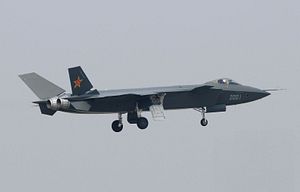Loyal readers of Flashpoints know any type of new Chinese military weapon or gadget is always a hot topic of conversation for this blog. And rightly so—Beijing has presented us defense geeks with new ballistic and cruise missile technology, a new carrier with rumors of a domestically built flattop allegedly under construction, fresh ICBM’s, increasingly advanced submarines and more. The rumor mill is always churning with new developments and technologies to digest and dissect.
The latest buzz coming from the always accurate Chinese press seems too good to be true: Beijing’s best and brightest—at least according to one expert—is looking out into the future and sees a need for China’s 5th generation stealth fighter to join carrier operations. Oh and by the way, the idea is to make them unmanned.
Now to be fair, the report in the People’s Daily on November 28th is more like speculation by a Chinese military expert than actual confirmations of a green-lighted project. Still, that such a report could be remotely taken seriously shows how far China’s defense industry has come in just the last few years.
“Interviewed by a reporter, military expert Li Li said that in the future China would need unmanned stealth attackers that could be transported by aircraft carrier or effectively partnered with the J-20.
When asked what kind of unmanned stealth attackers China would most need, Li Li answered that craft that could complete long-distance in-depth attacks on enemy targets would have to be large unmanned stealth planes weighing 6 to 10 tons, because only planes of such size and weight could carry sufficient ordinance.
In addition, the plane must have stealth capacity in order to be able to penetrate defensive perimeters. Although the cost of an unmanned plane is lower than that of a manned plane, the lower cost is of no value if the craft cannot meet mission requirements. Therefore, solving such problems as stealth material and aerodynamic shape represents a comprehensive development project.”
There is a lot to digest there; however, there are a few obvious points to be made. The biggest point is this: just because Beijing “needs” such a weapon in the future does not mean that it is coming off the factory floor anytime soon—and won’t.
For fun, let’s review the challenges China would face getting the idea off the ground—or off the carrier, so to speak.
First, China is years away from developing normal (carrier or unmanned) J-20 style fighters—period. Despite all the fancy photos and YouTube clips over the last two years, very few analysts believe such a plane will be combat ready and in full production for some time. As we have seen in the cases of the American F-22 and F-35—building a 5th generation fighter is not an easy feat. The technical expertise required to engineer, develop and test such a plane presents challenges even for the much more seasoned U.S. defense industry.
Even if China overcame these obstacles, it would next have to train pilots to fly such a plane, a process that can take years to build the competency needed in the skies for combat or to bomb targets in an integrated, 21st century battlefield. And considering the fact that China is still dependent on Russia for the engines that would power the J-20 and prior 4th generation designs—well, you get the point. It seems pretty clear such a “need” will be unmet for some time to come.
Also, a J-20 style plane that could be ported over to carrier operations—well, after China actually masters carrier operations that is—would be tough to develop in the first place. The current J-20 seems like a big plane and likely too heavy to be flown from a carrier unless modified significantly. China would need to develop a smaller version of the craft in order to make the short takeoff and landing spaces on a carrier work—a Chinese X-47B perhaps? You never know.
Although today we can confidently say such speculation coming from the People’s Daily is more fantasy than reality (it is after all the paper that declared China should dispute Japan’s sovereignty over Okinawa), the long-term trajectory of China’s growing military might cannot be denied. Considering Beijing’s recent decision to declare an Air Defense Identification Zone (ADIZ) East China Sea, it’s clear it will certainly need better tools to patrol the skies or take on regional challenges. If China declares another ADIZ in say the South China Sea, carrier aviation could be essential in ensuring the ADIZ is credible and enforced. But even carrier operations in the truest sense of the word are a long ways off—and so is China’s “need” for an ever greater leap in technology.

































